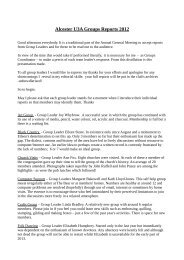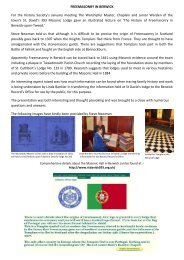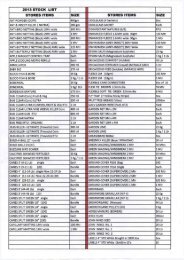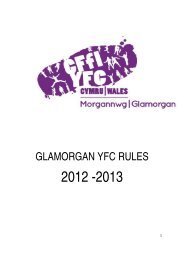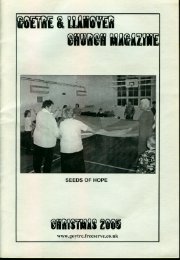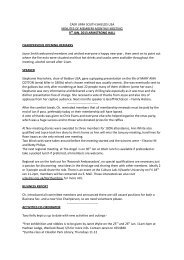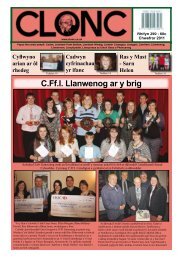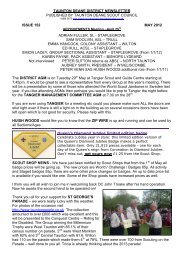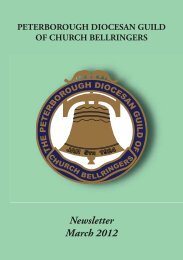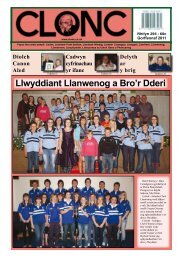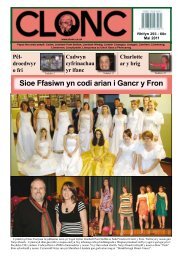Applying for a Definitive Map Modification Order Stump Cross ... - Net
Applying for a Definitive Map Modification Order Stump Cross ... - Net
Applying for a Definitive Map Modification Order Stump Cross ... - Net
Create successful ePaper yourself
Turn your PDF publications into a flip-book with our unique Google optimized e-Paper software.
<strong>Applying</strong> <strong>for</strong> a <strong>Definitive</strong> <strong>Map</strong> <strong>Modification</strong> <strong>Order</strong><br />
<strong>Stump</strong> <strong>Cross</strong> Lane is a track to the south-west of Tickhill, from Crooked Lane<br />
Head in a broadly south-westerly direction, passing Blythe Gate Farm and on<br />
to Woolthwaite Farm. About 800 metres of the track crosses land belonging<br />
to the Sandbeck Estate. The track is about 1km from the site of Tickhill<br />
Castle. A further 3km to the south-west is Roche Abbey and the hamlet of<br />
Stone, from where good quality limestone to build the castle and the friary<br />
was quarried. The track is about 5 metres wide, is usually dry and there are<br />
extensive views from it.<br />
The name <strong>Stump</strong> <strong>Cross</strong> Lane<br />
indicates that it has been in<br />
existence <strong>for</strong> at least several<br />
hundred years. Clearly there was<br />
once a cross here, later removed to<br />
leave a stump (since gone). Local<br />
historian Tom Beastall, in his book<br />
Tickhill: Portrait of an English<br />
Country Town, says that the<br />
name Woolthwaite is Anglo-Saxon,<br />
i.e. the period, from 954 until<br />
1086, be<strong>for</strong>e the Normans arrived in the area, and the track led directly to<br />
Lindrick, a settlement which existed be<strong>for</strong>e Tickhill itself. Additionally,<br />
historian David Hey, in his book The Making of South Yorkshire, says that<br />
Woolthwaite was a medieval settlement recorded in 1148 and lay within<br />
the honour of Tickhill (following the arrival of the Normans) and was the direct<br />
route to Tickhill Castle. He says, further, that the cross is likely to have been<br />
destroyed in the Re<strong>for</strong>mation.<br />
People from Tickill have enjoyed using it <strong>for</strong> recreational purposes over many<br />
years, walking, running and horse-riding. Some Tickhill residents remember<br />
walking the track in the 1930's, others worked on the Blythe Gate and<br />
Woolthwaite farms. Since the 1970's The Tickhill and District Footpath Group<br />
have walked on the track as part of their programme of walks. The Sheffield<br />
Ramblers used the route at one time. The Maltby Athletics Club used it<br />
regularly <strong>for</strong> their training runs, as did the Tickhill Running Club.<br />
In 2009 the Tickhill and District Footpath Group published a booklet Walks<br />
Around and About the Parish of Tickhill. One of these walks included <strong>Stump</strong><br />
<strong>Cross</strong> Lane, which at the time was not recorded as a public right of way. A<br />
month or two later the Group received a letter from the solicitors of the<br />
Sandbeck Estate, pointing this out. The Group acknowledged this, withdrew<br />
the walk from the remaining booklets, and re-printed the booklets without this<br />
walk.<br />
The Sandbeck Estate is the home of the Earl of Scarbrough, whose family<br />
have lived on the estate since the 16th Century. The manor was given by<br />
Idonea de Vipont, daughter and heir of John de Busli to the Monks of Roche<br />
Abbey in the 12 th century. After the Dissolution of the Monasteries, Sandbeck
was sold to a London syndicate <strong>for</strong><br />
£800. In 1545 the manor was<br />
bought by Robert Saunderson. His<br />
son Nicholas built a house at<br />
Sandbeck. The titles died out with<br />
the death of James Saunderson in<br />
1723 and the estate passed to a Mr<br />
Lumley who was related to the<br />
Saundersons through his mother,<br />
who had married the First Earl of<br />
Scarbrough. He took the surname<br />
Saunderson and became the Third<br />
Earl of Scarbrough in 1739. In<br />
2004 Viscount Richard Lumley<br />
succeeded his father as the 13th<br />
Earl of Scarbrough.<br />
Following the publication, and<br />
subsequent withdrawal, of the booklet Walks Around and About the Parish of<br />
Tickhill, in January 2010 signs appeared at either end of 800 metres of the<br />
track which crosses land owned by Lord Scarborough. It transpired that the<br />
increase in walkers along the track, due to the publication of the booklet,<br />
prompted this action. However, whatever the reason <strong>for</strong> the signs, I felt that it<br />
was an unnecessary course of action and totally unjustified. Apart from the<br />
history attached to the route, and the fact that local people had been using it,<br />
without problem, <strong>for</strong> many years, I could see no disadvantage to the<br />
landowner from the public using the track.<br />
The core of the problem was that <strong>Stump</strong> <strong>Cross</strong> Lane had never been claimed<br />
as a public right of way. To make a claim I would need to apply or a <strong>Definitive</strong><br />
<strong>Map</strong> <strong>Modification</strong> <strong>Order</strong> (DMMO). My first course of action was to download,<br />
from the Ramblers website, a witness statement <strong>for</strong>m. Then I began the<br />
process of finding witnesses and taking statements. The earliest user of<br />
<strong>Stump</strong> <strong>Cross</strong> Lane who I interviewed was a lady who walked it in the 1930's<br />
with her parents, a regular Sunday afternoon walk. Another witness worked at<br />
Blythe Gate Farm <strong>for</strong> four years in the 1960's, reporting that the farmer was<br />
very happy to accept that walkers and horse riders had unimpeded access<br />
along <strong>Stump</strong> <strong>Cross</strong> Lane. However, these early witnesses weren't very<br />
important as far as this particular application <strong>for</strong> a DMMO was concerned.<br />
The important time-span was the 20 years prior to the date that the public<br />
were first challenged, which turned out to be 2006. Finding witnesses was<br />
done by word of mouth, the final question from me to each witness being to<br />
ask if they knew anyone else who had used the track. Witnesses were asked<br />
to state when they had used the track, how regularly, and whether there had<br />
ever been any barriers or whether they had been challenged. I tracked down<br />
about 20 witnesses and the only witness who had ever been challenged was<br />
my neighbour who, in the 1980's, had regularly used <strong>Stump</strong> <strong>Cross</strong> Lane <strong>for</strong> an<br />
early morning run be<strong>for</strong>e he went to work as a pharmacist; he had once been<br />
challenged by the police, during the miners' strike, who thought he might be<br />
on his way to do some illegal picketing. So, as far as the quest <strong>for</strong> a DMMO
was concerned, none of the witnesses I interviewed had ever been<br />
challenged regarding their right to use the route.<br />
After taking 20+ witness statements I obtained two Form of Application <strong>for</strong> a<br />
<strong>Modification</strong> <strong>Order</strong> <strong>for</strong>ms (WCA1 and WCA2) from DMBC's Rights of Way<br />
Department and submitted them, plus the witness statements, to the Rights of<br />
Way Dept. The Rights of Way Dept then re-interviewed some of the<br />
witnesses be<strong>for</strong>e deciding to make a DMMO. They then had to in<strong>for</strong>m<br />
interested parties (i.e. the Sandbeck Estate) and advertise the order in the<br />
press, make the order available in the central and local libraries, and give a<br />
deadline <strong>for</strong> objectors to respond. Inevitably the Sandbeck Estate objected,<br />
which meant that a public inquiry was necessary.<br />
All documentation was sent to The Planning Inspectorate, in Bristol, who<br />
consulted all parties regarding setting a date <strong>for</strong> the Public Inquiry, and<br />
arranged <strong>for</strong> an inspector to be appointed. Meanwhile, as Applicant, I<br />
received copies of the Statement of Case from both DMBC and the Sandbeck<br />
Estate. The date <strong>for</strong> the inquiry was set <strong>for</strong> 11th December, with a second<br />
day being booked just in case it was necessary.<br />
A Public Inquiry (PI) is a <strong>for</strong>mal<br />
affair. The photo shows the<br />
Inspector sitting at the table at the<br />
end of Tickhill Parish Rooms, with a<br />
witness sitting at a table on the right.<br />
Doncaster Metropolitan Borough<br />
Council, on the right, were<br />
represented by a barrister, with<br />
George Diprose, DMBC's<br />
Rights of Way Officer, on his left. A<br />
DMBC clerk assists and maintains the attendance register. The Sandbeck<br />
Estate was represented by a solicitor, with the Estate Manager in the witness<br />
seat in this photo. Members of the public are clearly entitled to be present.<br />
The introduction by the inspector took 30 minutes. She was followed by the<br />
DMBC counsel giving his opening statement. He pointed out that the<br />
Sandbeck Estate had first lodged a deposition, questioning the right of the<br />
public to use the route, in October 2006. Hence the Council would seek to<br />
show sufficiency of use over the period 1986-2006. At issue with regard to<br />
<strong>Stump</strong> <strong>Cross</strong> Lane was the fact that it is not a frequently used route. It is<br />
outside Tickhill, and thus not frequented by regular dog-walkers. Counsel<br />
quoted various cases from the past, which indicated that frequency of use to<br />
be expected in the establishment of public rights on a path was related to the<br />
geographical setting. In the case of <strong>Stump</strong> <strong>Cross</strong>, lying outside a population<br />
centre the requirement was proportionately lower than if it had been within the<br />
built up area. He also made the point at at no time were barriers ever erected<br />
to deter the public, and that there were no signs erected until January 2010.<br />
DMBC's opening statement was followed by the Sandbeck Estate's opening<br />
statement. The Estate’s counsel sought to show that <strong>Stump</strong> <strong>Cross</strong> Lane was
arely used and that staff had<br />
standing orders to challenge<br />
users. He also sought to<br />
establish that it would only take<br />
about 15 minutes to walk along a<br />
track of about 800 metres, and<br />
thus actual use could rarely have<br />
been observed. Various<br />
witnesses were then called <strong>for</strong><br />
each side, answering questions<br />
directed to them by counsel. These witnesses were then questioned by the<br />
other side. DMBC called several witnesses, starting with the lady mentioned<br />
above, who had walked the route from the 1930s and, until recently, with the<br />
Tickhill Footpath Group. Another witness said that he had walked the route<br />
about 12 times annually on his way to see the orchids on Maltby Common.<br />
One witness (an international runner) recorded in his written statement<br />
running the route 700 times a year (twice daily) over a 2-year period without<br />
challenge. None of DMBC's witnesses reported being challenged by Estate<br />
staff. The tenant farmers of Woolthwaite Farm, owned by the Sandbeck<br />
Estate, stated that they had regularly challenged walkers. A tenancy<br />
agreement was produced which indicated that the tenant farmer was dutybound<br />
to ensure that no new public rights of way came into being. Discussion<br />
took place on how likely it would have been <strong>for</strong> staff, going about their work, to<br />
see and then whether they could realistically challenge users of the route.<br />
Two gamekeepers from the Estate said that they had challenged users,<br />
especially people with dogs not on leads and horse-riders using the route to<br />
gallop; one adjacent field is used <strong>for</strong> game cover.<br />
The inquiry moved into the second day. Further witnesses were questioned<br />
be<strong>for</strong>e counsel <strong>for</strong> each side gave their closing statements. All present then<br />
had a 45 minute lunch break be<strong>for</strong>e meeting at Woolthwaite Farm to walk the<br />
route. The Inspector made it clear that people were welcome to point out<br />
landmarks which had been referred to in the Inquiry, but that no further<br />
evidence could be allowed. After walking the route the inspector was asked<br />
when her report would be published; she simply said that she would publish it<br />
as quickly as she could. So, nothing more to be done but await her report.<br />
On 14th January 2013 the inspector's decision arrived. At the top of her 7page<br />
report, detailing what she considered to be the main issues, was<br />
'Summary of Decision: The <strong>Order</strong> is confirmed'. So, exactly three years from<br />
the date of the signs being erected at each end of the disputed track, DMBC's<br />
<strong>Order</strong> to alter the <strong>Definitive</strong> <strong>Map</strong> and make <strong>Stump</strong> <strong>Cross</strong> Lane into a public<br />
right of way was confirmed.<br />
Issues <strong>for</strong> consideration<br />
1 The process is not a quick one.<br />
2 Following my application, along with about 20 witness statements,<br />
Doncaster MBC checked the evidence and decided to make the <strong>Order</strong> to
modify the definitive map. Had they not done so, I could have appealed to<br />
the Secretary of State to ask him to direct the Council to make an order.<br />
3 Evidence is crucial. In addition to written witness statements, DMBC<br />
called several witnesses to speak at the inquiry. Evidence from the<br />
programmes of The Sheffield CHA Rambling and Social Club Winter<br />
Programme 1988-89, the Ramblers Sheffield Group Winter walks<br />
programme 1988-89, etc was also presented. All were demonstrating that<br />
these were publicly advertised walks, that permission had not been<br />
sought, and that the walkers had not been challenged on the route. One<br />
man who was asked to be a witness at the inquiry declined <strong>for</strong> medical<br />
reasons; an arrangement was made <strong>for</strong> him to make a sworn statement to<br />
a solicitor. Another man who would have been an excellent witness, the<br />
resident of Blythe Gate Farm, died a couple of months prior to the inquiry;<br />
depending on the cost, it might have been a good idea <strong>for</strong> him (and other<br />
elderly witnesses?) to have made a sworn statement.<br />
4 It is understood that each side meets its own costs.<br />
5 Taking statements from witnesses is a lengthy process. Although the<br />
statement is quite simple, perhaps a 5-10 minute job, you can't not chat<br />
about the issue with the witnesses. In reality, travelling to witnesses (who<br />
might be out, necessitating a return visit), and taking the statement,<br />
probably averaged an hour <strong>for</strong> each person.<br />
6 It is a fact of life that some people who could give useful witness<br />
statements don't wish to do so. Into this category I had a Tickhill councillor<br />
and a Tickhill shop-owner (where Lord Scarbrough shops). The latter<br />
person is heavily involved with the Tickhill Athletics Club, who regularly<br />
used the route; the evidence of many runners would have been useful.<br />
7 The inspector's decision is final. The only recourse open to the objector it<br />
to appeal to the High Court on a point of law.<br />
David Gadd<br />
23 January 2013



